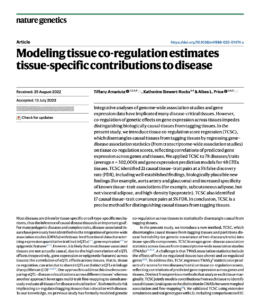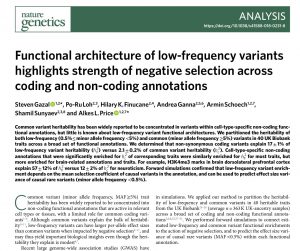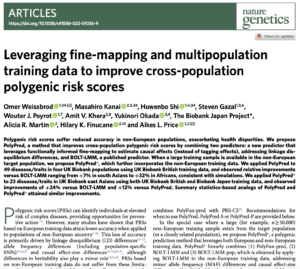Our research focuses on the development of statistical methods for uncovering the genetic basis of human disease, and on the population genetics underlying these methods. Areas of interest include:
Functional components of heritability
 Functional annotation data represents a great opportunity for the field of human genetics, as there is increasing evidence that genetic associations are concentrated in annotation classes spanning a small fraction of the genome. In contrast to approaches that rely on genome-wide significant associations to identify enriched regulatory and cell-type specific annotation classes, our research takes a heritability approach, leveraging genome-wide polygenic signals. Tissue co-regulation score regression paper (Amariuta et al. 2023). Also see scATAC-seq disease-critical types paper (Kim et al. 2024), Sc-linker paper (Jagadeesh*,Dey* et al. 2022), Single-cell disease relevance score paper (Zhang*,Hou* et al. 2022), Enhancer-related genes paper (Dey et al. 2022), Gene co-regulation score regression paper (Siewert-Rocks et al. 2022), LDpred-funct paper (Marquez-Luna et al. 2021), Functionally informed fine-mapping paper (Weissbrod et al. 2020), Mendelian pathogenicity scores for common disease paper (Kim et al. 2020), Deep learning heritability paper (Dey et al. 2020), TF binding heritability paper (van de Geijn et al. 2020), Transposable element heritability paper (Hormozdiari et al. 2019), Reconciling S-LDSC and LDAK paper (Gazal et al. 2019), Gene network connectivity paper (Kim et al. 2019), Regulatory element evolution paper (Hujoel et al. 2019), Functionally informed GWAS paper (Kichaev et al. 2019), Heritability enrichment of specifically expressed genes paper (Finucane et al. 2018), Latent Causal Variable (LCV) causal inference paper (O’Connor et al. 2018), Signed LD profile regression paper (Reshef et al. 2018), Heritability enrichment of molecular QTL paper (Hormozdiari et al. 2018), TWAS of schizophrenia and chromatin activity paper (Gusev et al. 2018), Functional heritability of gene expression paper (Liu et al. 2017), Summary statistics review paper (Pasaniuc & Price 2017), TWAS from summary statistics paper (Gusev et al. 2016), Prostate cancer functional heritability paper (Gusev et al. 2016), Functional heritability from summary statistics paper (Finucane et al. 2015), BOLT-REML paper (Loh et al. 2015), Genetic correlations from summary statistics paper (Bulik-Sullivan et al. 2015) and Functional heritability paper (Gusev et al. 2014).
Functional annotation data represents a great opportunity for the field of human genetics, as there is increasing evidence that genetic associations are concentrated in annotation classes spanning a small fraction of the genome. In contrast to approaches that rely on genome-wide significant associations to identify enriched regulatory and cell-type specific annotation classes, our research takes a heritability approach, leveraging genome-wide polygenic signals. Tissue co-regulation score regression paper (Amariuta et al. 2023). Also see scATAC-seq disease-critical types paper (Kim et al. 2024), Sc-linker paper (Jagadeesh*,Dey* et al. 2022), Single-cell disease relevance score paper (Zhang*,Hou* et al. 2022), Enhancer-related genes paper (Dey et al. 2022), Gene co-regulation score regression paper (Siewert-Rocks et al. 2022), LDpred-funct paper (Marquez-Luna et al. 2021), Functionally informed fine-mapping paper (Weissbrod et al. 2020), Mendelian pathogenicity scores for common disease paper (Kim et al. 2020), Deep learning heritability paper (Dey et al. 2020), TF binding heritability paper (van de Geijn et al. 2020), Transposable element heritability paper (Hormozdiari et al. 2019), Reconciling S-LDSC and LDAK paper (Gazal et al. 2019), Gene network connectivity paper (Kim et al. 2019), Regulatory element evolution paper (Hujoel et al. 2019), Functionally informed GWAS paper (Kichaev et al. 2019), Heritability enrichment of specifically expressed genes paper (Finucane et al. 2018), Latent Causal Variable (LCV) causal inference paper (O’Connor et al. 2018), Signed LD profile regression paper (Reshef et al. 2018), Heritability enrichment of molecular QTL paper (Hormozdiari et al. 2018), TWAS of schizophrenia and chromatin activity paper (Gusev et al. 2018), Functional heritability of gene expression paper (Liu et al. 2017), Summary statistics review paper (Pasaniuc & Price 2017), TWAS from summary statistics paper (Gusev et al. 2016), Prostate cancer functional heritability paper (Gusev et al. 2016), Functional heritability from summary statistics paper (Finucane et al. 2015), BOLT-REML paper (Loh et al. 2015), Genetic correlations from summary statistics paper (Bulik-Sullivan et al. 2015) and Functional heritability paper (Gusev et al. 2014).
Common vs. rare variant architectures of complex traits and the impact of negative selection

The gap between the estimates of the heritability explained by SNPs and total narrow-sense heritability has several possible explanations, including a rare variant contribution to complex trait architectures. We aim to understand the relative contribution of common and rare variants and the impact of negative selection, informing strategies for disease mapping and polygenic prediction using whole-genome sequencing data.
Low-frequency variant functional enrichment paper (Gazal et al. 2018). Also see Age-dependent topic modeling paper (Jiang et al. 2023), Case-case GWAS paper (Peyrot et al. 2021), Polygenicity paper (O’Connor et al. 2019), MAF-dependent architecture paper (Schoech et al. 2019), ASMC paper (Palamara et al. 2018), Mosaicism paper (Loh et al. 2018), LD-dependent architecture paper (Gazal et al. 2017), 2VC prediction paper (Tucker et al. 2015), LDpred paper (Vilhjalmsson et al. 2015), Admixture-based heritability paper (Zaitlen et al. 2014), Local heritability paper (Gusev et al. 2013), deCODE heritability paper (Zaitlen et al. 2013) (Research Highlight), Low-coverage sequencing paper (Pasaniuc et al. 2012), Excess-of-rare-variants paper (Price et al. 2010).
Disease mapping in structured populations
 Structured populations pose several technical challenges for disease mapping.
Structured populations pose several technical challenges for disease mapping.
Population stratification motivates the use of mixed linear models (MLM) and/or principal components analysis (PCA), but the question of how to maximize power using these methods is complex. In addition, it is currently unclear how to best combine data from multiple ethnicities. Cross-population prediction paper (Weissbrod*,Kanai*,Shi* et al. 2022). Also see PRS and family history paper (Hujoel et al. 2022), Cross-population genetic correlation in functional regions paper (Shi et al. 2021), Liability threshold modeling of family history paper (Hujoel et al. 2020), Cross-population genetic correlation paper (Galinsky et al. 2019), UK Biobank BOLT-LMM paper (Loh et al. 2018), Multi-ethnic risk prediction paper (Marquez-Luna et al. 2017), LT-Fam paper (Hayeck et al. 2017), UK Biobank selection paper (Galinsky et al. 2016), Reference-based phasing paper (Loh et al. 2016), Long-range phasing paper (Loh et al. 2016), FastPCA selection paper (Galinsky et al. 2016), BOLT-LMM paper (Loh et al. 2015), LD Score paper (Bulik-Sullivan et al. 2015), Liability Threshold MLM paper (Hayeck et al. 2015), MLM Perspective paper (Yang et al. 2014), African-American selection paper (Bhatia et al. 2014), Fst paper (Bhatia et al. 2013), PCA SNP weights paper (Chen et al. 2013), MIXSCORE paper (Pasaniuc et al. 2011), Africa selection paper (Bhatia et al. 2011) and Admixture review paper (Seldin et al. 2011).



